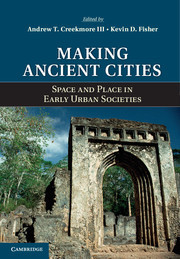Description
Making Ancient Cities
Space and Place in Early Urban Societies
Coordinators: Creekmore, III Andrew T., Fisher Kevin D.
Investigates how the structure and use of space developed and changed in cities, and examines the role of different societal groups in shaping urbanism.
Language: English
Making Ancient Cities
Publication date: 10-2019
441 p. · 17.7x25.5 cm · Paperback
Publication date: 10-2019
441 p. · 17.7x25.5 cm · Paperback
Making Ancient Cities
Publication date: 04-2014
437 p. · 18.2x26 cm · Hardback
Publication date: 04-2014
437 p. · 18.2x26 cm · Hardback
Description
/li>Contents
/li>Biography
/li>
This volume investigates how the structure and use of space developed and changed in cities, and examines the role of different societal groups in shaping urbanism. Culturally and chronologically diverse case studies provide a basis to examine recent theoretical and methodological shifts in the archaeology of ancient cities. The book's primary goal is to examine how ancient cities were made by the people who lived in them. The authors argue that there is a mutually constituting relationship between urban form and the actions and interactions of a plurality of individuals, groups, and institutions, each with their own motivations and identities. Space is therefore socially produced as these agents operate in multiple spheres.
1. Making ancient cities: new perspectives on the production of urban places Kevin D. Fisher and Andrew T. Creekmore, III; 2. The social production of space in third millennium cities of Upper Mesopotamia Andrew T. Creekmore, III; 3. North Mesopotamian urban neighborhoods at Titriş Höyük in the third millennium BC Yoko Nishimura; 4. Swahili urban spaces of the East African coast Stephanie Wynne-Jones and Jeffrey Fleisher; 5. The production of space and identity at classic period Chunchucmil, Yucatán, Mexico Aline Magnoni, Traci Ardren, Scott Hutson and Bruce Dahlin; 6. Making the first cities on Cyprus: urbanism and social change in the Late Bronze Age Kevin D. Fisher; 7. Urbanization and the emergence of the Greek polis: the case of Azoria, Crete Rodney D. Fitzsimons; 8. The rise of a Minoan city and the (re)structuring of its hinterlands: a view from Galatas D. Matthew Buell; 9. Cahokia: the processes and principles of the creation of an early Mississippian city John E. Kelly and James A. Brown; 10. Comparing east and west: aspects of urban manufacture and retail in the capitals of the Roman and Han empires Anna Razeto; 11. Ancient open space, gardens, and parks: a comparative discussion of Mesoamerican urbanism Barbara L. Stark; 12. Different cities Norman Yoffee.
Andrew T. Creekmore, III is Assistant Professor of Anthropology at the University of Northern Colorado. As part of his graduate work, he completed a Fulbright Fellowship in Turkey from 2002 to 2003. Creekmore's research areas include Near Eastern archaeology, High Plains archaeology, and archaeogeophysics. He is especially interested in how people organize themselves in space, in contexts ranging from Native American mobile forager campsites in the Rocky Mountains and Front Range of Colorado to Bronze Age cities of the Near East. Creekmore has conducted research in Turkey, Israel, Syria, Iraq, the eastern United States, and the plains of Colorado. His most recent publication in the area of urbanism and geophysics is in Archaeological Prospection.
Kevin D. Fisher is Assistant Professor of Eastern Mediterranean Archaeology at the University of British Columbia. He has been involved in archaeological research projects in Cyprus, Greece, Jordan, Guatemala, Peru, Canada, and the United States. Since 2008, he has been co-director of the Kalavasos and Maroni Built Environments (KAMBE) Project, a National Science Foundation-funded effort to explore the relationship between Late Bronze Age urbanism and social change on the island of Cyprus. Fisher's research interests include the social dynamics of built environments, urbanism, the origins and development of complex societies in the Eastern Mediterranean and Near East, and the application of geospatial and digital technologies in archaeological research. He has published widely on these topics in journals including the Journal of Mediterranean Archaeology and the Journal of Anthropological Archaeology.
Kevin D. Fisher is Assistant Professor of Eastern Mediterranean Archaeology at the University of British Columbia. He has been involved in archaeological research projects in Cyprus, Greece, Jordan, Guatemala, Peru, Canada, and the United States. Since 2008, he has been co-director of the Kalavasos and Maroni Built Environments (KAMBE) Project, a National Science Foundation-funded effort to explore the relationship between Late Bronze Age urbanism and social change on the island of Cyprus. Fisher's research interests include the social dynamics of built environments, urbanism, the origins and development of complex societies in the Eastern Mediterranean and Near East, and the application of geospatial and digital technologies in archaeological research. He has published widely on these topics in journals including the Journal of Mediterranean Archaeology and the Journal of Anthropological Archaeology.
© 2024 LAVOISIER S.A.S.




